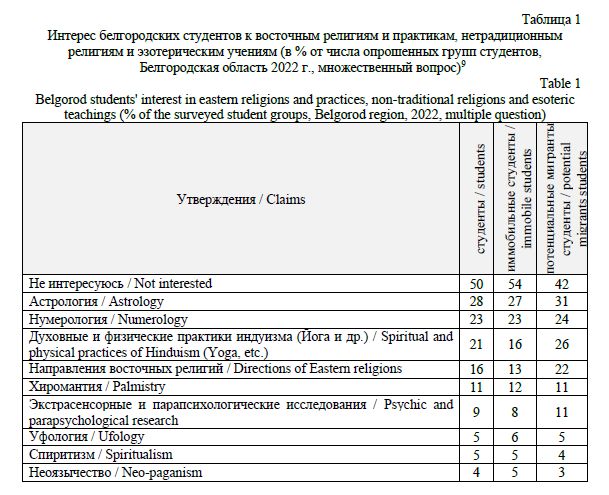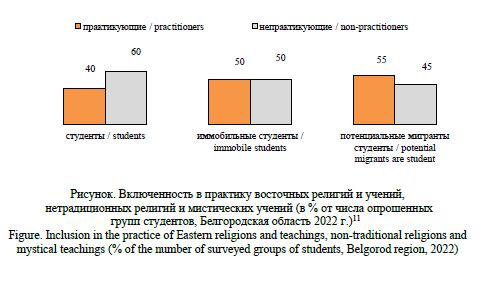Non-traditional religious views of Belgorod students
In the context of globalization, migration transformations and the growing differentiation of spiritual practices, the study of non-traditional religious views among young people acquires special relevance and socio-scientific significance. Modern social changes stimulate the search for new forms of religious identity and ways to satisfy spiritual needs, especially during periods of life transitions and uncertainty. The article examines the impact of migration mobility/ immobility on motivation, interest, formation and practical involvement in non-traditional religions and teachings among students. The article presents a comprehensive analysis of three groups of students: the general student population, 'potential immigrants', and 'immobile' students. The differences between these groups are revealed by their level of interest, motivation, and involvement in non-traditional religious teachings. The role of the social environment, in particular family traditions, which undoubtedly have an impact on inclusion in practice, even with low personal interest, is analyzed. The results show that student mobility enhances internal motivation and promotes more active spiritual self-determination, due to the need for social adaptation and the search for semantic supports in conditions of change, while “immobile” students demonstrate a significant role of the cultural environment in maintaining religious practice, even with a relatively low self-interest. This data emphasizes the complexity of the interaction of personal, socio-cultural and situational factors in the formation of non-traditional religious behavior. Understanding these mechanisms is essential for developing student support programs as well as for studying the processes of religious transformation in the context of globalization. The study contributes to a deeper understanding of the role of non-traditional religious movements in the modern youth environment.
Figures



Lyutenko, I. V. (2025), “Non-traditional religious views of Belgorod students”, Research Result. Sociology and management, 11 (3), 44-60. DOI: 10.18413/2408-9338-2025-11-3-0-3.


















While nobody left any comments to this publication.
You can be first.
Balagushkin, E. G. (1980), Netraditsionnye religii v kapitalisticheskih stranah Zapada i ih vliyanie na molodezh' [Non-traditional religions in the capitalist countries of the West and their influence on young people], Publishing House of Moscow State University, Moscow, Russia. (In Russian)
Balagushkin, E. G. (1999), Netraditsionnye religii v sovremennoy Rossii: morfologichesky analiz [Non-traditional religions in modern Russia: morphological analysis], Russian Academy of Sciences, Institute of Philosophy, IF RAN, Moscow, Russia. (In Russian)
Barker, A. (1997), Novye religioznye dvizhenya [New religious movements], Russian Christian Humanitarian Institute, St. Petersburg, Russia, EDN: MCHFLG. (In Russian)
Kublitskaya, E. A. (1990), “Traditional and non-traditional religiosity: the experience of sociological study”, Sociological Studies, (5), 95-103, EDN: BGWJUG. (In Russian)
Martinovich, V. A. (2024), Sotsialnaya identifikatsya novyh religioznyh dvizheny v Respublike Belarus [Social identification of new religious movements in the Republic of], RISH, Minsk, Belarus, ISBN: 978-985-586-794-5. (In Russian)
Martinovich, V. A. (2015), Netraditsionnaya religioznost: vozniknovenie i migratsya: Materialy k izuchenyu netraditsionnoy religioznosti [Non-traditional religiosity: emergence and migration: Materials for studying unconventional religiosity], 1, Minsk Theological Academy, Minsk, Belarus, ISBN: 978-985-7028-11-5. (In Russian)
Mitrokhin, L. M. (1985), Religii “novogo veka” [Religions of the “new century”], Soviet Russia, Moscow, Russia. (In Russian)
Rybakovsky, L. L. (2017), Istorya i teorya migratsii naselenya. Kn. 2: Migratsya naselenya: yavlenie, ponyatie, determinanty [History and theory of population migration, book 2: Population migration: phenomenon, concept, determinants], Publishing House “Econ-Inform”, Moscow, Russia, ISBN: 978-5-9500099-7-6, EDN: XTJZTV. (In Russian)
Rybakovsky, L. L. (2017), “Functions and consequences of migration processes”, Sociological Studies, (10), 56-63, DOI: 10.7868/S0132162517100063. (In Russian)
Yagelsky, A. (1980), Geografya naselenya [Geography of the population], Progress, Moscow, Russia. (In Russian)
Campbell, C. (2010), “The Easternisation of the West: or, How the West Was Lost”, Asian Journal of Social Science, 38/5, 738-757.
Campion, N. (2012). Astrology and cosmology in the world’s religions, New York University Press, 273, ISBN: 978-0-8147-1713-4.
Cresswell, T. (2010), “Towards a politics of mobility”, Environment and planning: society and space, 28, 17-31, DOI: 10.1 068/d11407.
Faggian, A., McCann, P. (2009), “Universities, agglomerations and graduate human capital mobility”, Tydschrift voor Economische en Sociale Geografie, 100 (2), 210-223, DOI: 10.1111/j.1467-9663.2009.00530.x.
de Haas, H. (2023), How migration really works: the facts about the most divisive issue in politics, 464. ISBN: 1541604326.
Lee, E. S. (1966), “A Theory of migration”, Demography, 3 (5), 47-57, DOI: 10.2307/2060063.
Heelas, P. (1996), The New age movement: religion, culture and society in the age of postmodernity, Wiley-Blackwell, 288, ISBN: 978-0-631-19332-6.
Parker, M. (1998), The New age movement: religion, culture and society in the age of postmodernity, Wiley-Blackwell, 288, ISBN: 978-0-631-19332-6.
Syaastad, L. A. (1962), “The costs and returns of human migration”, Journal of Political Economy, 70 (5/2), 80-93.
Schewel, S. (2019), “Understanding immobility: moving beyond the mobility bias in migration studies”, International Migration Review, 54 (2), 328-355, DOI: 10.1177/01979183198319
Stark, R., Bainbridge, W. S. (1987), A Theory of religion. Peter Lang: New York, 386.
Turner, V. (1969), The ritual process: structure and anti-structure, New York, 239, ISBN: 9781315134666.
Williams, A. M., Jephcote, C., Yanta, H., Li, G. (2017), “The migration intentions of young adults in Europe: a comparative, multilevel analysis”, Popul. Space Place, 24, DOI: 10.1002/psp.2123.
Whitehouse, H. (2004), Modes of religiosity: a cognitive theory of religious transmission, Bloomsbury Academic, 193, ISBN: 0759106150, 9780759106154.
Wolter, A. (2020), “Migration and higher education in Germany”, Inequality, Innovation and Reform in Higher Education, 39-57.